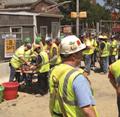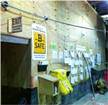
Testing a Better Recognition Tool
Can we reward workplace safety without discouraging accident reports? Our research points a way forward.
- By Mia Goldwasser, Emily Sparer, Jack Dennerlein
- Apr 01, 2013
Incentive programs that reward workers for avoiding accidents and injuries have been a mainstay of occupational health and safety programs in construction and many other industries for years. Employers offer free lunches, raffles, and prizes to workers when their department, factory, or construction site achieves a set number of days without a workplace injury. These programs are attractive because counting injury-free days offers a quick and easy way to measure safety performance and explain the results to workers. However, injury-based incentive programs have recently come under fire from OSHA -- and for good reason.
Rewarding low recorded injury rates and disqualifying individual workers or an entire group from receiving a reward when an injury occurs can lead to a reduction in injury reporting instead of a reduction in actual injuries. The prospect of a reward, after all, creates a material incentive for the workforce to conceal accidents and injuries in the workplace. This not only creates a false measure of the safety of work environment, but also prevents all parties involved from identifying and fixing real problems in the work environment or safety culture. The March 2012 OSHA directive "Employer Safety Incentive and Disincentive Policies and Practices" drew the line on these programs:
"Incentive programs that discourage employees from reporting their injuries are problematic because, under section 11(c) [of the Occupational Safety and Health Act], an employer may not ‘in any manner discriminate’ against an employee because the employee exercises a protected right, such as the right to report an injury.... If an employee of a firm with a safety incentive program reports an injury, the employee, or the employee's entire work group, will be disqualified from receiving the incentive, which could be considered unlawful discrimination."
Yet injury-based incentive programs are still all too common. In a recent study by Duke University's Hester Lipscomb, 58 percent of carpenter apprentices reported some form of an injury-based incentive program -- or a disincentive program tied to reported injuries -- on their current work site. Workers expressed a fear of reprisal at these sites, should an injury be reported. And the problem of underreporting in the industry was a real one: A majority of workers said that injuries were "rarely," "never," or only "sometimes" reported on their current job sites. The study provides compelling evidence of negative consequences when work site programs discipline workers for injuries and accidents.
A More Accurate Reflection of Site Safety
Our research team at the Harvard School of Public Health and Northeastern University understands that communicating safety performance on-site and recognizing safe work practices are important goals and are critical to improving site safety culture and reducing injury rates. As a result, with support from CPWR – The Center for Construction Research and Training, we have been designing and testing a novel safety communication and recognition program called "Building Safety for Everyone." The program provides an infrastructure to recognize workers for working safely and reducing job-related hazards before an accident happens.
 At the heart of the program is data from routine safety inspections to evaluate the physical working conditions and practices of a site. These data provide a snapshot of safety performance before an incident occurs -- looking for "leading indicators" rather than reading "lagging indicators" such as accident reports. Safety managers record safe and unsafe observations with an easy-to-use software program. The observations are then weighted to generate an overall site safety performance score (the percentage of safe observations out of the total observations).
At the heart of the program is data from routine safety inspections to evaluate the physical working conditions and practices of a site. These data provide a snapshot of safety performance before an incident occurs -- looking for "leading indicators" rather than reading "lagging indicators" such as accident reports. Safety managers record safe and unsafe observations with an easy-to-use software program. The observations are then weighted to generate an overall site safety performance score (the percentage of safe observations out of the total observations).
Unsafe observations are weighted by risk severity (low, medium, high, life-threatening), with the higher-severity items deducting greater values. Safe observations are weighted by hazard category (e.g., confined space, housekeeping, electrical safety, fall protection), with work practices protecting against severe injury risks assigned higher point values. The weights help provide a more accurate reflection of the site safety, putting more emphasis on safety management systems than on the simple use of PPE.
Regular communication of these safety performance scores to foremen and workers employed by each contractor or subcontractor on the site drives the program. Foremen receive a weekly summary report of all safe and unsafe observations recorded for their company and are encouraged to discuss the report with their crews. Workers can read the whole-site inspection score on centrally located on-site posters where the scores are tracked and displayed. If and when the site safety performance score exceeds a pre-determined inspection threshold, the whole site is recognized for working safely with a free lunch and a raffle for a high-value item (for our urban work sites, the prize has been a cherished one-month parking spot in a nearby garage). Hence, the program emphasizes the role of communication in maintaining safe working conditions and practices through providing constant feedback to workers and foremen. It also relies on positive reinforcement, regularly recognizing workers for their role in reducing hazards on the work site.
To date, we have partnered with five general contractors in the Boston area to implement it and evaluate its effect on site safety. We are still collecting data and are analyzing the program's full impact, but our experience to date has been very positive. On the commercial construction sites where we have tested the program, workers and management noted an increase in cooperation and safety awareness. "The key ingredient of this program is that it promotes teamwork," said one site superintendent.
Workers who participated in the program also noticed increased interaction among trades as they sought to collectively boost their site scores. One worker noted, "The trades were working together with the program, and other trades were watching out for everyone else. Normally they would never do that, but now I see talking amongst the trades -- this came from the program." Another commented that it "absolutely affected safety conditions. The awareness has gone way up. The job became a lot cleaner, there were a lot less tripping hazards, and I would say friendlier."
Workers also have reported that the program has improved communication between workers and management. "It helps you be able to bring safety issues to their [management's] attention. Before, if there was a safety issue, you'd stay away from it and keep your mouth shut. But they want you to be safe. It makes you more of a participant."
Next Steps
The B-SAFE program has more to do. Once we complete our current testing of the system, we need to determine how the program works when implemented by a contractor without the support of our research team. As part of that effort, our team is developing an online version of the program that will provide all of the materials and information necessary for owners and general contractors to implement the program on their own work sites.
Safety management systems are vital to the reduction of injuries on a site. The Building Safety for Everyone program provides an opportunity to augment these systems with performance communication systems that transcend the traditional organizational aspects of the site and do away with the discriminatory nature of traditional employee safety programs. It is time to move away from incentive programs based on recorded injury rates and toward programs that recognize safe working conditions and practices. We need to prevent injuries from occurring, not just keep them off the books.
Research for the study in this article was provided through CPWR's cooperative agreement with the National Institute for Occupational Safety and Health, NIOSH (OH009762).The contents of this article are solely the responsibility of the authors and do not necessarily represent the official views of NIOSH.
References
1. Lipscomb HJ, Nolan J, Patterson D, Sticca V, Myers DJ [2012]. Safety, incentives, and the reporting of work-related injuries among union carpenters: "You're pretty much screwed if you get hurt at work." American Journal of Industrial Medicine. [Epub ahead of print].
2. Sparer EH, Dennerlein JT [2013]. Determining safety inspection thresholds for employee incentives programs on construction sites. Safety Science 51(1): 77–84
This article originally appeared in the April 2013 issue of Occupational Health & Safety.